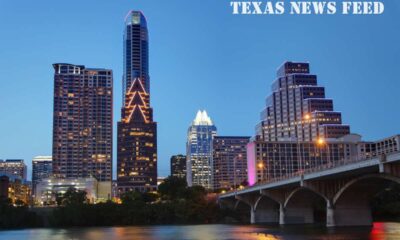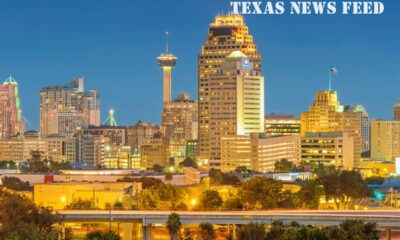Texas News
Limited regulations make Texas workers responsible for preventing on-the-job heat injuries
Limited regulations make Texas workers responsible for preventing on-the-job heat injuries
“Limited regulations make Texas workers responsible for preventing on-the-job heat injuries” was first published by The Texas Tribune, a nonprofit, nonpartisan media organization that informs Texans — and engages with them — about public policy, politics, government and statewide issues.
Sign up for The Brief, The Texas Tribune's daily newsletter that keeps readers up to speed on the most essential Texas news.
Maynor Estuardo Álvarez used to stand the Texas heat, but not anymore.
Something changed in his body last summer while working as a painter in an apartment in Houston. It was the afternoon, the temperature had surpassed 100 degrees and the unit had no air conditioning. He suddenly felt his heart racing and started sweating profusely. His calves cramped, then his arms, followed by an unbearable pain under his ribs.
He called his wife and told her: “I think I'm about to faint.”
She advised him to drink water, but he said he was already doing so.
“Get out of there then,” she said.
Álvarez moved to another unit with air conditioning, drank more water and finally recovered. He did not leave work as his wife urged him to do, but the incident did change his views about working on really hot days.
Álvarez has dealt with heat stress on other occasions during his 18 years working in construction since he came to Texas from his native Quetzaltenango, Guatemala. But he feels the heat has taken its toll on his body and, a year after the Houston incident, he still cannot expose himself to such high temperatures.
He isn't willing to do so either.
Álvarez worried about his health again when a heat wave this year pushed Texas temperatures into triple digits. The heat has eased for now, but temperatures are forecast to climb again in the coming days. This puts construction workers like Álvarez at risk, as well as others in sectors like agriculture, mail delivery, manufacturing, food preparation and landscaping.
There are no federal or state standards that specifically protect workers from heat illness, and Texas cities and counties will soon be barred from making local rules with that purpose. Now more than ever, like Álvarez's case shows, heat safety depends on workers being trained in self-care, supervisors learning to identify symptoms of heat stress and employers' willingness to provide breaks and other protective measures.
Heat kills more people annually in the U.S. than hurricanes, tornadoes or flooding. Texas has recorded 42 heat-related deaths on the job since 2011 — more than any other state, according to U.S. Bureau of Labor Statistics data.
Since the start of the heat wave, at least two workers have died in Texas from causes that officials are investigating as possibly heat-related. Justin Cory Foster, a 35-year-old lineman, died in the East Texas town of Marshall, and Eugene Gates Jr., a 66-year-old letter carrier, died in Dallas.
Work safety experts and unions say that heat-related deaths are probably undercounted because many are registered as related to other causes.
While 2022 was the second-hottest year on record, milder temperatures are forecast for this summer. But that does not preclude heat waves like the one last month. Climate change amplifies heat waves, which become more frequent, last longer and reach higher temperatures, scientists have told The Texas Tribune.
How to prevent exposure to heat hazards
Workers exposed to high temperatures can suffer heat stress or heat stroke. The Occupational Safety and Health Administration recommends paying attention to symptoms such as headaches, nausea, weakness or dizziness, heavy sweating, elevated body temperature, thirst, decreased urination and hot, dry skin. When these happen, OSHA advises drinking water; moving to a fresh area; cooling off with water, ice or a fan; and removing unnecessary clothing.
Heat strokes are more serious. They could manifest as abnormal thinking or behavior, slurred speech, seizures and loss of consciousness. Workers might not realize when they're displaying heat stroke symptoms and depend on coworkers, supervisors or others for help. In these cases, OSHA recommends immediately calling 911 and cooling the worker with water or ice.
Identifying dehydration can be difficult, said David Delgado, 58, a construction supervisor in Laredo. Last year, while working at a construction site on a day when temperatures reached 108 degrees, he didn't realize the heat was getting to him until his feet cramped up.
“You do not get thirsty,” Delgado said. “The body does not realize it.”
According to Delgado, workers in his team usually drink plenty of fluids before starting their day because access to water can be far from building sites and they want to finish the project as quickly as possible. But they need to drink water frequently to stay hydrated, so he established a 10-minute break every three hours. During this year's heat wave, his crew repaired the roof of a 30,000-square-foot auto parts store. To avoid heat illness, Delgado moved up the workday: They started at 6 a.m. and finished at 1 p.m.
“We do not recommend working from 1 p.m. to 5 p.m. under the sun,” Delgado said. “But we have to work because we have to eat, right?”
To prevent heat injuries, OSHA advises drinking at least one glass of water every 20 minutes, resting from the heat in the shade or in cool places, wearing loose-fitting, light-colored clothing and a hat, and being aware of coworkers.
Last year, the agency launched an education campaign highlighting that three out of four heat-related deaths occur during the first week of working on a new project. That's why the agency proposes gradually increasing exposure to the heat as the work week goes by. OSHA recommends not spending more than 20% of the first day's work shift exposed to the heat, and increasing that amount of time by 20% each day until the work week is completed.
Texas is hot and humid, which makes it harder to cool the body by sweating and can lead to dehydration, said Bethany Boggess Alcauter, director of Research and Public Health Programs at the National Center for Farmworker Health.
Postal employees tend to work alone and that makes them especially vulnerable to heat, said William Moody, president of the Letter Carriers of the National Association Branch 181, which includes Austin and its surroundings. In addition to OSHA's recommendations, Moody urges U.S. Postal Service customers to keep an eye on letter carriers' health and assist them if they notice erratic behavior.
“It takes the whole community to look out, not only for letter carriers but anybody that works in the heat,” Moody said. “Sometimes it is just talking to the person and making sure they are coherent.”
The U.S. Postal Service said in a statement that only 34% of its current vehicles have air conditioning. The statement said the agency was acquiring more vehicles equipped with air conditioners and providing mandatory heat-related training for all workers.
Heat protection standards
When the June heat wave hit, Juan Pedro Muñoz, 45, was siding a house in Austin. He has worked in construction for two decades, since arriving from Querétaro, Mexico. The crew with whom he works schedules 10-minute water breaks about every hour to cope with the high temperatures. That's more than the mandatory rest required by an Austin ordinance.
“We never had a problem with the breaks,” Muñoz said. “We talked to the supervisor and he told us he would rather have us working than in the hospital.”
However, Muñoz said he knew this is not always the case. Workers that spoke to the Tribune said some supervisors won't let them take a break — and they won't have to either since the Austin ordinance is likely to be repealed soon.
Gov. Greg Abbott signed House Bill 2127 at the height of the heat wave. Known as the “Death Star law,” HB 2127 limits Texas cities and counties from creating rules that go beyond what state law requires on issues such as labor, agriculture, business and natural resources.
No one really knows exactly which local laws will become illegal when the bill goes into effect on Sept. 1. Months after the bill first went before lawmakers and weeks after Abbott signed it into law, cities still are trying to figure out the scope of the law. But it expressly mentions that local governments cannot regulate work breaks. The law is expected to result in the overturning of ordinances in Austin and Dallas that require workers to take 10-minute water breaks every four hours. It will also impede other cities from adopting similar rules.
Unions have argued that the law would increase the risk of heat-related injuries and deaths on job sites. This will particularly affect Latinos, who represent six out of 10 construction workers in Texas, according to U.S. Census Bureau data.
Supporters of HB 2127 say it will eliminate a patchwork of local ordinances across the state that bog down businesses, and that OSHA guidelines are enough to ensure a safe workplace.
Safe workers are good for business, Geoffrey Tahuahua told the Tribune last month after HB 2127 was signed. Tahuahua is the president of Associated Builders and Contractors of Texas, which represents commercial building companies.
He supports the new law because he considers that local ordinances try to impose one-size-fits-all solutions to businesses. Tahuahua said he prefers OSHA guidelines because they allow employers to set safety plans that fit each job site and type of work. Someone welding steel 50 feet in the air in the middle of a hot day should rest more than other construction workers, he said.
“We take it very seriously,” Tahuahua said. “My members are far above and beyond what the markets are up to, but flexibility is really important.”
However, OSHA does not have a national standard specific to heat-related illnesses. The agency relies on the general duty clause, a section of federal labor law that requires employers to protect workers from serious occupational hazards. But that broad standard is not enough to ensure workers are protected from heat exposure, said Douglas Parker, head of OSHA. That is why the agency is working on creating a national heat standard, he said.
“Ten years ago, if you raised the idea of a national heat standard, that was still considered a fringe issue. And there were questions about whether OSHA should be involved,” Parker said. “I think that there is growing recognition of the need to do something about it, combined with a huge amount of information and data about climate change.”
Parker also said that OSHA didn't have enough inspectors to regularly keep an eye on all the companies and workers exposed to heat in the country. He believes a national standard would increase compliance without the need for more inspections.
Parker said the general duty clause is so broad that it gives employers the flexibility to make their own heat safety plans — but it also creates confusion. OSHA often receives inquiries from companies that do not know what measures to take to protect their workers, most of which could be resolved with a national standard.
Although discussions on creating a standard are at an early stage, Parker anticipated that it would take into account preventive measures like having access to water, offering breaks under the shade, acclimatizing workplaces and offering instructions on how to deal with emergencies.
But it can take years to enact a federal OSHA standard. Parker noted that, in the past, this process has taken an average of seven years and, in the case of major rules, up to 20 years. He believes this process might be shorter because it is a priority for the Biden administration, which hopes to complete the new standard during this term.
There are still employers who fail to ensure workers' safety in hot environments, despite OSHA recommendations and the general duty clause. And that puts them at risk, as it happened to Álvarez last year.
Álvarez said safety and breaks depend on the arbitrariness of the foreman on duty.
“Sometimes the foreman is a kind person and brings you water, but there are others who want to please the boss, want to advance faster and more production, so they don't bring water nor allow us to take a break to relax a little bit.”
Over time, Álvarez learned that he must take breaks — even if he is not authorized.
“I have been sent home several times because they say I am rebellious, that if they give me breaks the other workers will want the same. And I do not get paid for the day,” he said. “But I do not care if they send me home. Working until I lose my life is not worth it.”
Join us for conversations that matter with newly announced speakers at the 2023 Texas Tribune Festival, in downtown Austin from Sept. 21-23.
This article originally appeared in The Texas Tribune at https://www.texastribune.org/2023/07/12/workers-texas-heat-wave/.
The Texas Tribune is a member-supported, nonpartisan newsroom informing and engaging Texans on state politics and policy. Learn more at texastribune.org.
Did you miss our previous article…
https://www.galvestontrendingnews.com/?p=6434
Texas News
North Galveston jetty crash: 3 hospitalized, 2 missing, family fears Beryl’s impact on Coast Guard search
SUMMARY: Two individuals are missing after a boat collided with a jetty in North Galveston, Texas. The U.S. Coast Guard reported the incident occurred at 9:30 p.m. on Friday, involving five adults. By Saturday morning, three adults had been rescued and taken to the hospital, though their conditions remain unknown. The search for the two missing individuals is ongoing, but family members are concerned that approaching weather, specifically Beryl, could impede the search efforts. The situation's outcome heavily depends on weather conditions as the storm nears Texas' coast.
The post North Galveston jetty crash: 3 hospitalized, 2 missing, family fears Beryl's impact on Coast Guard search appeared first on abc13.com
Texas News
Flies in Texas: Are there more right now and why?
SUMMARY: In Texas, residents have observed an unusual rise in fly populations, particularly exacerbated in recent years. The phenomenon, discussed by Central Texans on Reddit, aligns with insights from Texas AgriLife Entomologist Wizzie Brown. She explains that the state's warm climate supports year-round fly activity, with heat accelerating their life cycle, leading to rapid population growth. Climate change is likely worsening the issue, as higher temperatures benefit flies and expand their habitable areas. To manage the infestation, Brown suggests regular trash removal, using outdoor garbage bins, and cleaning these bins with dish soap to eliminate fly-attracting odors.
The post Flies in Texas: Are there more right now and why? appeared first on www.kxan.com
Texas News
Suspect arrested after 10-year-old boy was hit and killed riding bike in northwest Harris County on July 4th, authorities say
SUMMARY: A driver, 36-year-old Alex Tuan Vuong, has been arrested and charged with failure to stop and render aid after allegedly hitting and killing 10-year-old Mohammad Khel on July 4th in Harris County, Texas. Mohammad was struck by a dark SUV while riding his bicycle in the Grand Oaks subdivision. Vuong is currently held in the Harris County jail. Investigators reported that after running a stop sign and hitting Mohammad, the driver continued for nearly a mile with the boy’s bike wedged underneath, before stopping to remove it at Greenhouse and Kieth Harrow.
The post Suspect arrested after 10-year-old boy was hit and killed riding bike in northwest Harris County on July 4th, authorities say appeared first on abc13.com
-
Texas News4 days ago
I-10 westbound from Beaumont to Houston reopens day after large crack prompted closure at Washington Boulevard
-
Texas News6 days ago
Body found below North State Highway 3 bridge, family used Find My Friends app to find him, League City PD says
-
Podcasts5 days ago
CHAD MAULDIN on Being A Talent Cultivator
-
Texas News6 days ago
Train collides with car carrying grandfather, 2 grandchildren on County 236 in Brazoria County, police say
-
The Center Square5 days ago
U.S. Supreme Court declines to rule whether social media feeds are free speech | National
-
Videos7 days ago
Tomball’s Asher Hong representing USA Men’s Gymnastics Team in 2024 Olympic Games
-
Texas News7 days ago
Too many passwords to remember? Here’s what you can do
-
Podcasts5 days ago
Talkin’ Texas | Texans at the Olympics, Fresh Water Sharks, and Bats!
/https://static.texastribune.org/media/files/48c1e6efc1178cd1f5153941d6935b4c/0706%20Heat%20Construction%20Features%20JT%20TT%2008.jpg)
/https://static.texastribune.org/media/files/86fa80dadd5b43032db60be86362c362/0706%20Heat%20Construction%20Features%20JT%20TT%20015.jpg)
/https://static.texastribune.org/media/files/e13db5419c3c3d5371b80b528287f9da/0706%20Heat%20Construction%20Features%20JT%20TT%2013.jpg)
/https://static.texastribune.org/media/files/1ba6f1db596890c6c46948efd9f2a9a0/0707%20Workers%20Heat%20Wave%20JT%20TT%205.jpg)
/https://static.texastribune.org/media/files/bd1303b1c282081de4864abee91e3128/0707%20Workers%20Heat%20Wave%20JT%20TT%2024.jpg)
/https://static.texastribune.org/media/files/3af045ea29c3a9273b4f40af175eaf25/0707%20Workers%20Heat%20Wave%20JT%20TT%2037.jpg)
/https://static.texastribune.org/media/files/5ea112ca36a5e530d1013ac2f8f306cc/0706%20Heat%20Construction%20Features%20JT%20TT%2006.jpg)










































